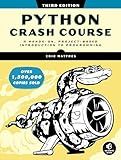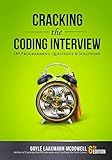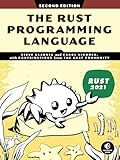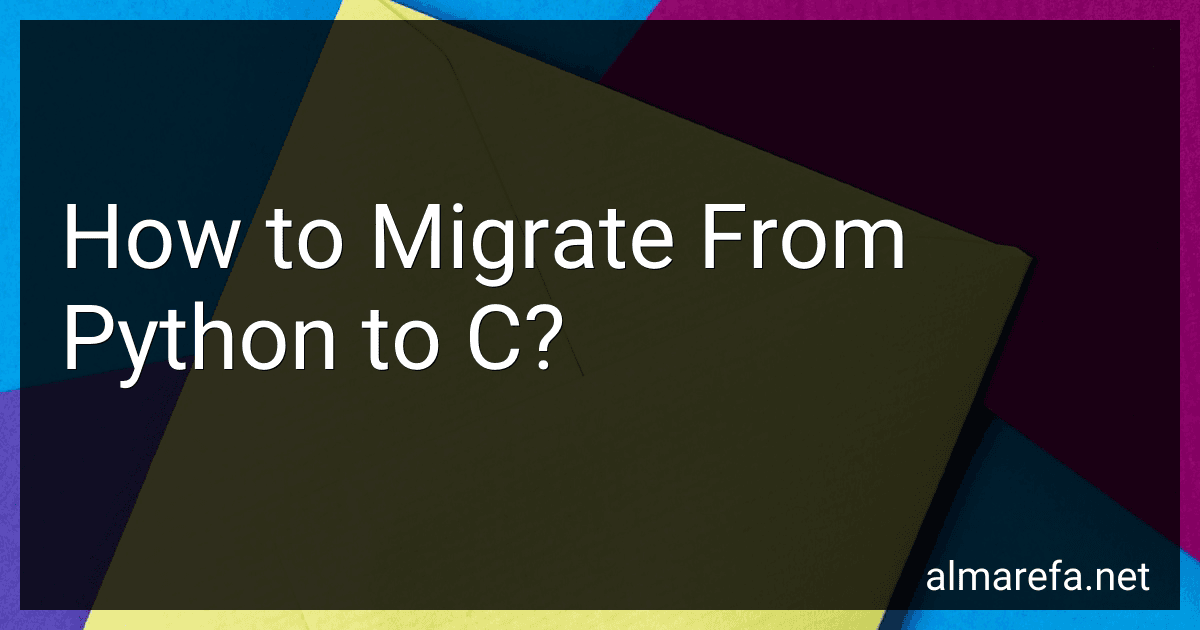Best Programming Books to Buy in November 2025

Python Crash Course, 3rd Edition: A Hands-On, Project-Based Introduction to Programming



Beginner's Step-by-Step Coding Course: Learn Computer Programming the Easy Way (DK Complete Courses)



Code: The Hidden Language of Computer Hardware and Software



Cracking the Coding Interview: 189 Programming Questions and Solutions
- EASY-TO-READ FORMAT BOOSTS COMPREHENSION AND ENGAGEMENT.
- COMPACT DESIGN MAKES IT PERFECT FOR ON-THE-GO PROFESSIONALS.
- GOOD CONDITION ENSURES RELIABILITY AND VALUE FOR YOUR PURCHASE.



Everything You Need to Ace Computer Science and Coding in One Big Fat Notebook: The Complete Middle School Study Guide (Big Fat Notebooks)



The Pragmatic Programmer: Your Journey To Mastery, 20th Anniversary Edition (2nd Edition)



The Rust Programming Language, 2nd Edition


Migrating from Python to C involves transitioning from a dynamically-typed scripting language to a statically-typed compiled language. Here are some key points to consider when making this transition:
- Syntax Differences: Python and C have different syntaxes. C is a low-level language where you need to manage memory manually, whereas Python abstracts memory management for you. Familiarize yourself with the syntax and rules of writing C code.
- Data Types: C has a range of primitive data types such as int, float, char, etc. Unlike Python, you need to explicitly declare the type of variables in C. Ensure that you understand the type requirements of your code and assign appropriate types.
- Memory Management: In Python, memory management is handled by the interpreter, using garbage collection. But in C, you need to explicitly allocate and deallocate memory using functions like malloc() and free(). Be mindful of memory leaks and ensure proper memory allocation and deallocation in your C code.
- Conditional Statements: Conditional statements such as if-else and switch-case have similar functionality in both Python and C, but the syntax and structure differ. Familiarize yourself with the variations in syntax while translating your Python code to C.
- Loops: Python offers multiple types of loops like for, while, etc. The syntax of loops in C is different, and you need to carefully translate your Python loops to C syntax.
- Libraries and Modules: Python has an extensive standard library and a vast ecosystem of third-party libraries and modules. C, on the other hand, has a comparatively limited standard library. Identify if you need any external libraries to accomplish your tasks in C and ensure they are compatible and available.
- Error Handling: Python provides built-in exception handling mechanisms, whereas C handles errors using return codes or error codes. Update your error handling strategy accordingly while migrating to C.
- Testing and Debugging: Python offers several testing frameworks and debugging tools. Similarly, C has its own set of testing frameworks and debugging utilities. Familiarize yourself with these tools and incorporate them into your C development workflow.
- Performance Considerations: C is generally faster and more efficient than Python due to its low-level nature. Utilize C's performance advantages by optimizing your code and taking advantage of features like pointers and direct memory access.
- Portability: Python offers portability across different platforms without modification. Depending on the specific C implementations and platform-dependent features used, your C code may need to be compiled separately for different operating systems and architectures.
It's important to plan and thoroughly understand the differences between Python and C before attempting to migrate. Start by translating smaller Python code snippets or modules into C and gradually migrate larger parts of your codebase.
What is the compiled file format for C code?
The compiled file format for C code is typically an executable file with the file extension ".exe" (for Windows) or without any extension (for Unix-based operating systems like Linux and macOS).
How to ensure compatibility during the migration from Python to C?
Migrating from Python to C involves rewriting the Python code in C, which requires careful consideration to ensure compatibility. Here are some key steps to ensure compatibility during the migration process:
- Understand the differences: Python is a high-level, interpreted language, while C is a low-level, compiled language. Understand the fundamental differences between the two, such as strong typing, memory management, and lack of built-in functionality in C compared to Python.
- Analyze Python code: Thoroughly analyze the existing Python codebase to identify its core logic, dependencies, and libraries being used. Understanding the codebase will help you plan the migration and identify potential challenges.
- Plan the migration strategy: Create a detailed plan and roadmap for the migration process. Determine the components or modules that need to be migrated first, taking into account dependencies and interdependencies. Prioritize critical features or functionalities to minimize disruptions during the migration.
- Separate concerns: During the migration, separate the concerns between core logic and specific Python libraries or frameworks being used. Focus on rewriting the core logic in C while considering alternative solutions for Python-specific libraries or frameworks.
- Design data structures and algorithms: Python provides built-in data structures and algorithms, whereas C requires implementing them manually. Design and implement the necessary data structures and algorithms in C that are being used in the Python code.
- Prepare the C environment: Set up the development environment for C, including compilers, build systems, and necessary libraries. Ensure all required tools and resources are available in C to compile and run the migrated code.
- Rewrite Python code in C: Begin rewriting the Python code in C by translating the code structure, logic, and algorithms. Pay attention to data types, memory management, error handling, and input/output operations, which differ significantly between Python and C.
- Test and validate: Thoroughly test and validate the migrated C code to ensure it produces the expected results. Perform unit testing, integration testing, and stress testing to identify and fix any issues or discrepancies.
- Performance optimization: As C is a lower-level language, take advantage of its performance benefits by optimizing the code where necessary. Identify bottlenecks and apply optimizations such as algorithm improvements, memory management enhancements, or code refactoring.
- Incremental migration: Consider an incremental migration approach where you migrate small sections of code at a time and thoroughly test the migrated sections before moving on. This reduces the risk of introducing bugs or compatibility issues in the whole codebase.
- Document and maintain: Document the changes made during the migration process to help future developers understand the code. It is essential to continue maintaining and updating the migrated C codebase to keep it compatible with new requirements or changes.
Remember that migrating from Python to C is a complex process, and it is crucial to involve experienced developers familiar with both languages to ensure a successful and compatible transition.
What is the process to compile C code generated from Python?
To compile C code generated from Python, follow these steps:
- Install a C compiler: You will need a C compiler, such as gcc, installed on your system.
- Generate the C code: Write your Python code that generates C code. Use Python's built-in libraries like ctypes or external libraries like Cython to generate C code from Python.
- Save the C code: Save the generated C code in a separate file with the .c extension, for example, "output.c".
- Open a terminal or command prompt: Open a terminal or command prompt on your system.
- Navigate to the directory: Change the current directory in the terminal to the directory where your C code file is located. You can use commands like cd to navigate to the directory.
- Compile the C code: In the terminal, run the command to compile the C code file. For example, if using gcc, the command would be: gcc -o output output.c This command compiles the "output.c" file and creates an executable file named "output".
- Run the compiled code: Once the compilation is successful, you can run the compiled code by running the generated executable file. In this example, you would run the command: ./output This will execute the compiled C code and produce the desired output.
Note: The specific commands and options may vary depending on your operating system and compiler. Make sure you have the necessary permissions to compile and execute code on your system.
How to handle Python-specific features in C programming?
When working with Python-specific features in a C program, you have several options to handle them:
- Embedding Python: You can embed the Python interpreter into your C program using the Python/C API. This allows you to call Python code and access Python-specific features directly from your C program. You can include the necessary Python header files and use functions provided by the API to execute Python code, manipulate Python objects, and handle exceptions.
- Extending Python: If you want to write C functions that are accessible from Python code, you can create an extension module. This involves writing C code that conforms to the Python/C API and compiles into a shared library. The compiled module can then be imported and used by Python code, and the C functions can interact with Python objects and APIs.
- Calling Python scripts: If you have separate Python code that you want to execute from your C program, you can use the system() function or similar functions to execute the Python interpreter as a subprocess and pass it the required Python script to run. This approach allows you to leverage existing Python scripts without the need for direct interaction between C and Python code.
- Using ctypes: The ctypes module in Python allows you to call functions in shared libraries (such as C libraries) directly from Python code. You can create ctypes bindings for your C functions and data structures, allowing you to access and use them from Python. This approach is useful when you have existing C code that you want to use in Python without embedding or extending the Python interpreter.
Each approach has its own use cases and trade-offs, so choose the one that best fits your specific requirements and constraints. Note that working with Python-specific features in C may require a good understanding of both languages and their respective APIs.
What is the role of a Python-to-C converter in migration?
A Python-to-C converter plays a significant role in migration by facilitating the transition of Python code to C code. Here are some key aspects of its role:
- Performance Enhancement: The primary purpose of converting Python code to C is to optimize performance. C is a low-level language that is generally faster and more efficient than Python. The converter ensures that the converted code maintains the functionality of the original Python code while leveraging the speed advantages of C.
- Integration with Existing C Code: In cases where a project already contains portions written in C or relies on existing C libraries, the converter helps to bridge the gap between Python and C. It converts the Python code into C, enabling seamless interoperability with the existing C codebase.
- Porting to Resource-Constrained Environments: Python may not be suitable for resource-constrained environments, such as embedded systems or environments with limited memory or processing abilities. The converter aids in porting Python code to C, allowing it to run efficiently in these environments where C-based solutions are more common.
- Algorithm Protection: By converting Python code to C, the converter helps protect sensitive algorithms or intellectual property. Since C code is harder to reverse engineer compared to Python, converting code to C can provide an additional layer of security.
- Codebase Maintenance: In some cases, an organization may decide to migrate from Python to C because of the language's easier maintainability or long-term support. The converter assists in transforming the Python code into C, enabling easier maintenance and ensuring the codebase remains sustainable.
- Cross-Platform Compatibility: Converting Python code to C can aid in achieving cross-platform compatibility. C code can be compiled to run on various operating systems and architectures, allowing code that was originally written in Python to be executed on different platforms seamlessly.
Overall, the Python-to-C converter plays a crucial role in optimizing performance, integrating with existing code, porting to resource-constrained environments, protecting algorithms, maintaining the codebase, and achieving cross-platform compatibility during the migration process.
How to handle Python's high-level features in C programming?
When working with Python's high-level features in C programming, there are a few steps you can take to handle them effectively:
- Understand the high-level feature: Before attempting to handle a specific high-level feature in C, make sure you have a clear understanding of how it works in Python. Read the relevant Python documentation or guides to get a grasp of the feature's purpose and behavior.
- Identify the equivalent functionality in C: Figure out the equivalent or similar functionality available in C for the high-level feature you want to work with. C may not have the exact same feature, but often there are alternative approaches that can achieve similar results.
- Determine the requirements and constraints: Analyze the specific requirements and constraints of your use case. Consider performance considerations, memory management, and any other relevant factors that may impact your implementation choices.
- Use appropriate libraries if available: Many high-level features in Python are implemented using external libraries. Check if any libraries exist in C that provide similar functionality. For example, if you need to work with regular expressions, you can use the regex.h library in C.
- Write custom implementations if needed: If there is no library available or if you need to optimize performance, you may have to write custom implementations for the high-level feature in C. This might involve using appropriate data structures, algorithms, or system calls to achieve the desired functionality.
- Test thoroughly: Thoroughly test your implementation to ensure it behaves correctly and handles corner cases. Write test cases that cover various scenarios and validate the behavior against the expected results.
- Optimize if necessary: Depending on the requirements, you might need to optimize your implementation for performance. Analyze the bottlenecks and potential areas of improvement. Techniques such as algorithmic optimizations, caching, or parallel processing might be helpful.
Remember that handling high-level features in C usually requires more manual effort compared to Python, as C is a low-level language. However, it also offers greater control and performance benefits when used effectively.
